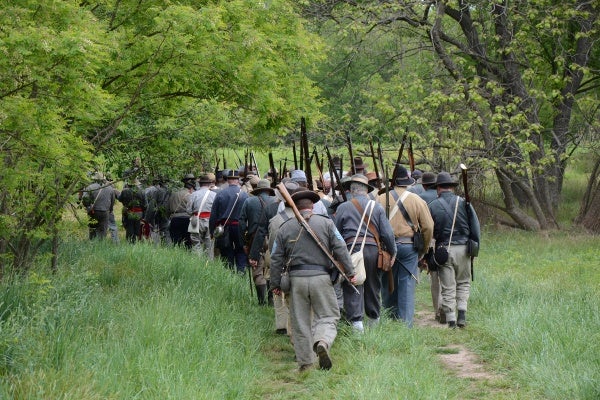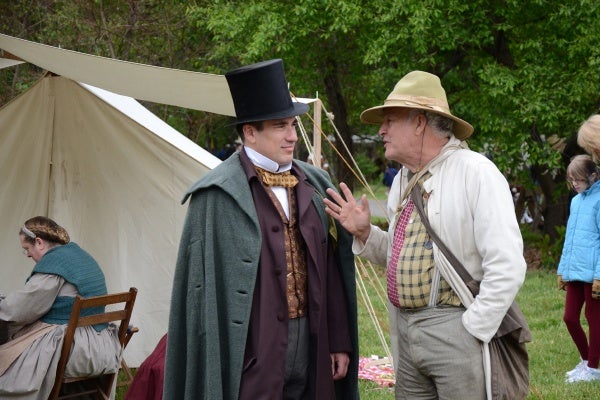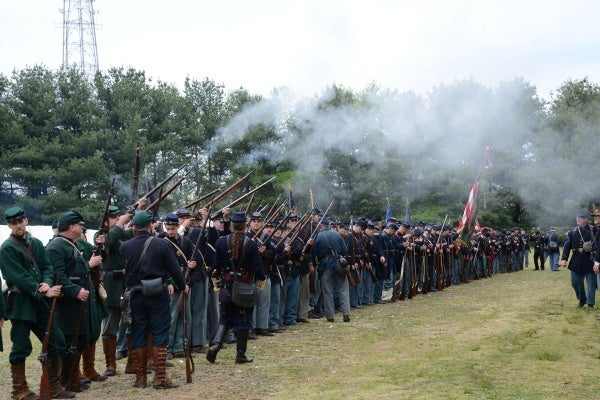Exploring the feminine side of Civil War
-

-

-

(Max Matza/for NewsWorks)
-

-

-

-

-

-

-

-

-

-

-

-

-

-

-

-

The 28th Virginia Infantry, Company D, has a website. On it are tips for women to pass as men on the battlefield: Cut hair short, or tuck it under a standard military hat — there are no ponytails; no fingernail polish; and artificial facial hair is not necessary. It suggests ladies wear restrictive bras to flatten the chest.
“Try wearing bike shorts under your uniform pants,” the website suggests. “They will stop feminine jiggle.”
This weekend, hundreds of Civil War re-enactors will congregate at Neshaminy State Park near Bensalem, Pa. No battle was fought at that location, but in at least one respect it will be historically accurate — women will be disguised as men in combat.
Historians have no accurate estimate of how many women passed as men on the battlefield during the Civil War. Many were never revealed. Newspaper accounts, memoirs, and personal letters of the time suggest it was not uncommon.
At Neshaminy this weekend, Kristin Bubranksy will be portraying “Chris Reed,” a fictitious character from Virginia who took up arms for the South.
“Chris supports the Confederate cause, and she wants to help her country get independence from the tyrannical government of the Union,” said Bubranksy, who in real life is an occupational therapist in Reading, Pa. “So she took her brother’s clothes — who had already enlisted — and went far enough away so they would not know her, adopted a different name, and joined the ranks.”
Bubranksy’s character is driven primarily by patriotism. Curiously, the made-up back story also includes running away from an arranged marriage. Many “passing” women of the time were likely from the lower classes, poor, and looking for a better life.
“For the woman who was working before the war as a laundress, going into the army wasn’t any harder a job, and she’d double her pay,” said Deanne Blanton, author of “They Fought Like Demons: Women Soldiers in the American Civil War.”
“They had anonymity, they had freedom, they could vote, the money was theirs,” Blanton said.
Neither the North nor the South officially allowed women to fight. But, as the war dragged on, officers in the struggling Confederate army turned a blind eye to women fighting openly. After the war, if they kept up the lie, women could draw a soldier’s pension.
“How many women lived their whole adult life as men? Well, we don’t know because if they were successful at it, their headstone has their male identity,” said Blanton. “It was this whole underground thing going on in Victorian America of women seeking more opportunity for themselves. And the way to do that was for society to think they were men.”
On the battle re-enactment scene, the lies layer. Bubranksy, who describes herself as a petite 5’1, will play a woman who plays a teenage boy who would have lied about his age to join the army (a common fib, then seen as noble).
Blanton says many men who organize re-enactment units prefer not to have women in their ranks, even when women argue that their presence is historically accurate. The fight to fight continues now, as then.
WHYY is your source for fact-based, in-depth journalism and information. As a nonprofit organization, we rely on financial support from readers like you. Please give today.




